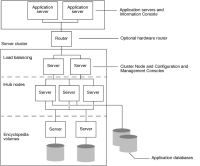About a cluster configuration
In the simplest configuration, an iHub cluster consists of two iHub nodes. A node is a single machine in a cluster. You can add nodes to a cluster to scale iHub System to your requirements. You install iHub on each node in a cluster. The node gets its configuration from a template in acserverconfig.xml, which is located in a shared configuration home directory. After the node is configured, it joins the cluster.
Figure 9‑1 shows the relationships between a cluster and its Encyclopedia volumes, application servers, and database servers.
Figure 9‑1 An iHub cluster
In this example, the cluster uses a network router to create a single virtual IP address to distribute the load-balancing requests that come into two nodes. The Actuate Information, Configuration, and Management Consoles support distributing requests to multiple machines, which handle load balancing in the cluster.
Figure 9‑1 shows the following cluster sections:

In the load-balancing section, the requests are routed to a node that performs load balancing.

In the nodes section, iHub generates documents and delivers them to clients for viewing.

In the Encyclopedia volumes section, iHub running on multiple machines maintains Encyclopedia volume management information and controls access to the volumes. The volumes can be on machines that are not running iHub but are accessible to a machine. A node shares all volumes.
In
Figure 9‑1, separate machines handle separate functions. You can combine these functions on one machine.

